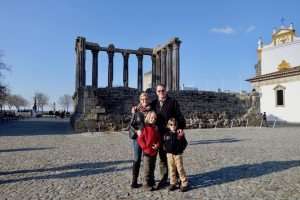Top Four Reasons to Travel to Bordeaux!
December 6, 2024
Bordeaux is well known for being the wine capital of the world, and with good reason. Bordeaux produces at least 400 million liters of -…
Read This Post Why visit Portugal on a cooking vacation? There are many reasons, but one of them is amazing Évora, where you stay during our Delectable Portugal culinary vacation. Évora is a city in the eastern Alentejo region (pronounced “all-en-TAY-zhoo”). This is a beautiful agricultural region known for it’s slow, relaxed lifestyle (to the point that there are numerous sayings about the Alentejano’s indolence!). One of its primary crops is cork, and because of this the ecology is naturally organic – chemicals are bad for the cork oak trees, hence they are simply not used.
Why visit Portugal on a cooking vacation? There are many reasons, but one of them is amazing Évora, where you stay during our Delectable Portugal culinary vacation. Évora is a city in the eastern Alentejo region (pronounced “all-en-TAY-zhoo”). This is a beautiful agricultural region known for it’s slow, relaxed lifestyle (to the point that there are numerous sayings about the Alentejano’s indolence!). One of its primary crops is cork, and because of this the ecology is naturally organic – chemicals are bad for the cork oak trees, hence they are simply not used.
See all out Portugal cooking vacations.
 The Alentejo’s capital city is Évora, founded in the 12th century and a hub of various cultural heritages, including Celtic, Roman, Arab, and Jewish. For centuries it housed a Royal residence of the Portuguese King, which was first a summer residence, but became in the 15th century the primary residence of King John II and then his successor Manuel I. This was one of the centers of the Portuguese Renaissance and Age of Discovery (to the extent that the “Manueline” style of the Portuguese late Gothic period is so named for Manuel I.) It’s historic center has been a UNESCO world heritage since 1986.
The Alentejo’s capital city is Évora, founded in the 12th century and a hub of various cultural heritages, including Celtic, Roman, Arab, and Jewish. For centuries it housed a Royal residence of the Portuguese King, which was first a summer residence, but became in the 15th century the primary residence of King John II and then his successor Manuel I. This was one of the centers of the Portuguese Renaissance and Age of Discovery (to the extent that the “Manueline” style of the Portuguese late Gothic period is so named for Manuel I.) It’s historic center has been a UNESCO world heritage since 1986.
Learn about Five Things to Eat in Portugal.
 Besides being full of charming shops, wonderful restaurants, and a friendly population, Évora is home to or nearby many sites to see, including:
Besides being full of charming shops, wonderful restaurants, and a friendly population, Évora is home to or nearby many sites to see, including:
The Sé de Évora is one of the city’s most distinctive buildings, and it sits at the highest point of the historical center. Originally begun in the 12th century, it underwent additions and renovations throughout the centuries but maintains its imposing Gothic presence.
Read about Portuguese Vinho Verde and the Port wines of Portugal.
 The Capela dos Ossos (Chapel of the Bones) in the Church of St. Francis is one of Évora’s most visited sites. The small chapel’s walls are literally covered with human skulls and bones. It’s quite impressive! The entrance to the chapel bears the ominous warning: Nós ossos que aqui estamos pelos vossos esperamos” (We bones that are here await yours!).
The Capela dos Ossos (Chapel of the Bones) in the Church of St. Francis is one of Évora’s most visited sites. The small chapel’s walls are literally covered with human skulls and bones. It’s quite impressive! The entrance to the chapel bears the ominous warning: Nós ossos que aqui estamos pelos vossos esperamos” (We bones that are here await yours!).
 Évora’s Temple of Diana is, along with the Cathedral, the most clearly recognizable landmark in Évora. A Roman temple build around the first century A.D., it was likely not dedicated to Diana at all, but the name has stuck! Its history was one of being ruined and pilfered for building materials over the centuries, but for some four or five hundred years it housed a butcher shop! The temple was restored in the 19th century. Interestingly, the temple is surrounded by the buildings associated with the Portuguese inquisition.
Évora’s Temple of Diana is, along with the Cathedral, the most clearly recognizable landmark in Évora. A Roman temple build around the first century A.D., it was likely not dedicated to Diana at all, but the name has stuck! Its history was one of being ruined and pilfered for building materials over the centuries, but for some four or five hundred years it housed a butcher shop! The temple was restored in the 19th century. Interestingly, the temple is surrounded by the buildings associated with the Portuguese inquisition.
 Lying a stone’s through from the Roman temple is the Convento dos Lòios. This 15th-century building is known for its Manueline-Renaissance style, and it now houses one of the country’s Pousada hotels. (Interested in staying there? We can make it happen!)
Lying a stone’s through from the Roman temple is the Convento dos Lòios. This 15th-century building is known for its Manueline-Renaissance style, and it now houses one of the country’s Pousada hotels. (Interested in staying there? We can make it happen!)
 Start or end your Évora journey in Lisbon with a Lisbon cooking class or our Lisbon Food Tour.
Start or end your Évora journey in Lisbon with a Lisbon cooking class or our Lisbon Food Tour.
The cromeleques of Almendres date back to the 6th century BC and were rediscovered in the 1960’s. There are thousands of years of history in the creation of the complex. To get to it you have to traverse a long gravel road deep into the countryside outside of Évora where the stones spread in a circular pattern one a large slope. There is also a single menhir located nearby.
Check out classic Portuguese recipes for tomatada, bacalhau, and even risotto!
Portugal is practically littered with castle ruins. It is perhaps the single most distinctive and unexpected thing I remember about my first trip there. First built by the Romans and the Moors as defensive strongholds, many of the castles were rebuilt by the Portuguese in the 12th and 13th centuries. The Alentejo region has dozens of castles, many of them within a very easy drive of Évora.
Want to learn more? Visit Portugal! You can explore this beautiful, amazing city yourself on our Delectable Portugal cooking vacation. Contact us for details! Or, check out our Portugal video:
By Peg Kern
Sign up to receive our newsletter, which includes travel tips, recipes, promotions, and information on our best cooking vacations.
Find more photos, videos, food facts, and travel stories from The International Kitchen on Facebook, Instagram, Pinterest, Twitter, and YouTube.